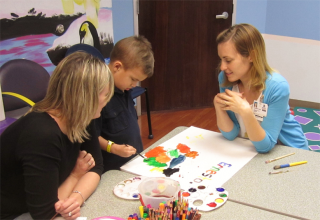Health
Yes, Virginia, There Is Some Art Therapy Research
There is more evidence on art therapy than you think.
Posted February 27, 2013

Kathleen Sutter at Tracy's Kids
Practitioners in the field of art therapy are always excited when the field gets some good press. This week the BBC released a nice piece on art therapy, including a short film on art therapy in a medical setting interviewing pediatric patients and art therapists (see below). The piece seeks to answer the question, "Can unleashing inner creativity heal the sick?" A pediatric patient, Ryan, interviewed in the film has no doubt. "It makes you feel like you can do anything really," he says of art therapy.
While the film provides an enthusiastic review of art therapy in a pediatric medical setting, the content fell short when it comes to citing the advances art therapy has made in this area. Of all the areas where research has been conducted, the most compelling and exciting art therapy data is emerging in the healthcare arena. Here are a few of the important studies**:
- Several studies demonstrate that art therapy enhances the psychosocial treatment of cancer, including decreased symptoms of distress, improved quality of life and perceptions of body image, reduction of pain perception, and general physical and psychological health (Monti et al, 2006; Nainis et al, 2002; Svensk et al, 2009).
- Studies indicate a reduction of depression and fatigue levels in cancer patients on chemotherapy (Bar-Sela,et al, 2007).
- Art therapy strengthens positive feelings, alleviates distress, and helps individuals to clarify existential questions for adult bone marrow transplant patients (Gabriel, Bromberg, Vandenbovenkamp, Kornblith, & Luzzato, 2001).
- Research with children with cancer indicates that engaging in drawing and painting is an effective method for dealing with pain and other disturbing symptoms of illness and treatment (Rollins, 2005).
- Research on art therapy with children with asthma indicates that it reduces anxiety, improves feelings of quality of life, and strengthens self-concept (Beebe, Gelfand, & Bender, 2010) (see Art Therapy and Health Care for more information).
- Evidence indicates that art therapy and other creative arts therapies stimulate cognitive function in older adults who have dementia or related disorders (Levine-Madori, 2009) and may reduce depression in those with Parkinson’s disease (Elkis-Abuhoff et al, 2008).
- Art making may reduce anxiety and stress reactions as measured by cortisol (Walsh et al, 2007).
I also want to point out that Dr. Elizabeth Warson, professor at The George Washington University, has been a major contributor and proponent of art therapy research involving several healthcare-related studies with Native Americans confronted by cancer diagnosis. Warson’s interests also include measurements of biomarkers [physiological aspects] in relation to art therapy interventions. This makes good sense since the field of art therapy embraces the belief that art therapy is part of a spectrum of interventions designed to improve quality of life, decrease perceptions of illness, pain and disability, serve as a form of stress reduction, moderate mood, and increase or at least maintain cognitive functioning. Measuring the association of art therapy interventions to various physiological responses, along with qualitative methods, is a powerful way to increase our knowledge of what art therapy can do for those with medical challenges.
So, yes Virginia, I am happy to say that there is some exciting art therapy research that supports the growing notion that creative expression is good for us. What is even more exciting is that most of this research underscores what art making can do for us in terms of “feeling better” rather than using art for strictly evaluative purposes. We have all sorts of instruments for the latter, from brain scans to credible diagnostic inventories. It is the former—the “feeling better” aspect—that can truly be defined as “health-enhancing” and tells us that art therapy actually complements medical treatment to produce positive health outcomes.
Cathy Malchiodi, PhD, LPAT, ATR-BC, LPCC
© 2013 www.cathymalchiodi.com
For more information on art therapy and mind-body medicine, please visit this page at http://bit.ly/TiJfO2 (current projects and events on art therapy, expressive arts therapy and integrative medicine).
Join delegations from 20 countries at the International Conference on Art Therapy in Shenzhen, China, May 15th and 16th, 2013! More information, see http://www.asiartherapy.org.
**Please visit my author page to download a PDF of the references for these studies. See Art Therapy and Healthcare Bibliography on list.


